Wow, peeps! They are publishing electronic books now. :-)
Chinese and Japanese Hair Ornaments by the Creative Museum.
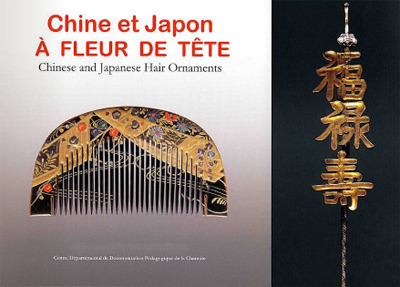

Wow, peeps! They are publishing electronic books now. :-)
Chinese and Japanese Hair Ornaments by the Creative Museum.

In 1644, the Northern Manchurians conquered China, defeating the ethnic Hans in the South. They named their dynasty Qing, meaning clear, as the Hans’ Ming Dynasty (1368 – 1644) ended. While the Manchurians integrated with the Chinese, many rebellions and tribal wars took place. In 1912, the Manchus lost power to the Republic of China.
Thank you to Jiarui Lu for sending in the correct scholarship. “Today, the Manchu, or Man Nation is one of 56 nations of China. The original place is northeast of China, and now most of “Man” people live in Liaoning province, Jilin province and Heilongjiang province of China.”
However, during the Qing Dynasty, the Manchu comb makers created outstanding three-dimensional hair ornaments with kingfisher feathers, as well as coral, amber, and jade. They were supposed to bring their royal wearers good luck.
Here are two examples. The first is from the Creative Museum’s Asian Collection. The second is mine. I got it on E-bay from a woman whose seaman father brought it home from China in the 1920’s.
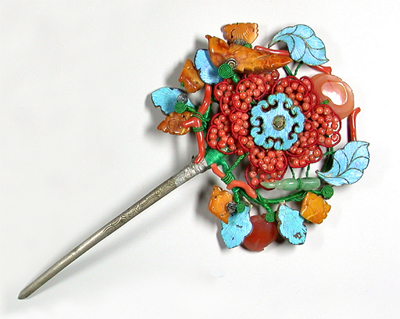
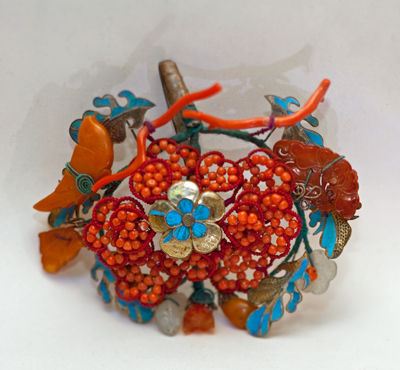
The stark contrast between what the Manchurians made for themselves and what they made for Victorian England reinforces China’s understanding of the West. I think they still understand us better than we will ever understand them. However, looking at these hair combs, I cannot help but ask, “Can reflection, caution, patience, and discipline supersede courage, freedom of thought, and innovation?”
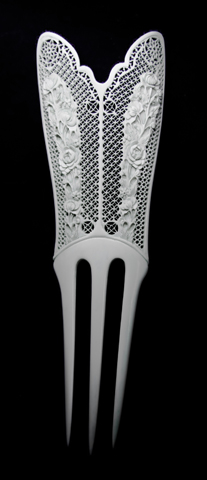
I am working with lights, a friend’s instructions, flashes, oh my God there is so much to think about… :-) Here are four comb pictures from my collection. The first is a Chinese ivory export comb for the Victorian market, c. 1890. The second is a Chinese hair stick with a blonde shell bird on top. Last is a Japanese Meiji ivory set in perfect condition, which depicts flowers blowing in the wind. Enjoy!
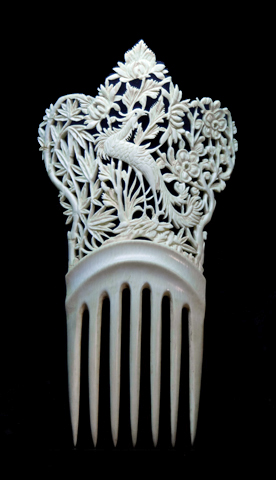
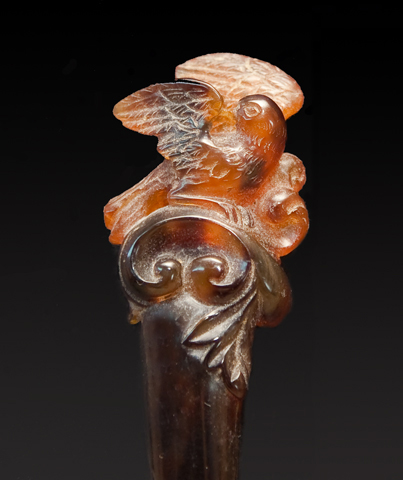

In 1936, the Duke of York (later King George VI) bought this tiara for Queen Elizabeth II’s mother, the Queen Mum. Cartier called it the “Halo” tiara. A fashion journalist also dubbed it the “Scroll” tiara. Both names stuck.
Wedding costume tradition dictates “something old, something new, something borrowed, something blue.” As her mother gifted the tiara to Queen Elizabeth II on her 18th birthday, so the Queen loaned it to Kate on her wedding day.
That Princess Catherine, Duchess of Cambridge, wore a priceless antique is thrilling. That she also has Diana’s engagement ring puts her at the pinnacle of provenance. She looked radiant.
It’s on sale on E-bay for $2500. In the Victorian Era, coral jewelry was said to promote good health. Seeing this and not being able to buy it promotes agony, so I’m not sure the Victorian theory has transposed well into the 21st Century. ;-) Branch coral on tortoiseshell, c. 1890. It’s a knockout.
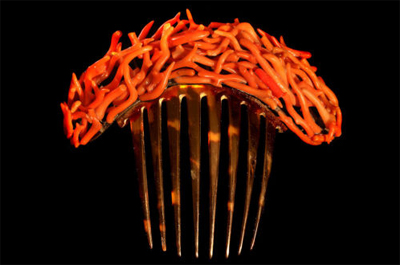
Par Creative Museum
Au Japon, deux figures animales associées reviennent très souvent comme motif décoratif. Il s’agit de la grue et de la tortue.
De nombreux kanzashi en sont ornés mais on les retrouve aussi sur les miroirs, les broderies des kimonos ou des ‘fukusa’ (carré de soie pour envelopper un cadeau) et sur beaucoup d’autres accessoires.
La Grue et la Tortue représentent les deux aspects complémentaires et radicalement opposés de l’univers : l’oiseau est le symbole de la liberté dans le ciel et du détachement de l’esprit face aux événements de la vie ; la tortue est le symbole de l’attachement à la terre et de la stabilité du monde.
On peut se demander pourquoi un manteau d’algues est toujours accroché à sa queue. Cela s’explique par une très ancienne légende qui raconte qu’une tortue, Minogamé, vit depuis 10 000 ans au fond des eaux, traînant derrière elle un lourd écheveau d’algues fixé à sa carapace.
Par ailleurs la grue tout comme la tortue vivent très longtemps, De ce fait, elles symbolisent ensemble la longévité et le bonheur et sont donc souvent représentées sur les kanzashi de mariage.
Please see comment #2 for the English translation.
The kanzashi’s original purpose was a charm against evil spirits. The tradition began as early as 1000 BC to 300 AD, in Japan’s Jomon Era. Decorating them with flowers invited deities. The art captured the Japanese cultural imagination in the Edo era (1603 – 1867), when criminal activity increased. This initiated laws that prohibited people from going out in hats or head coverings, so hairdressing once again came to the forefront of Japanese fashion.
There are many different kinds of kanzashi:
The most interesting ones have unique elements, either as a single decoration or a set of concepts. I’d like to feature three today, one each, from my collection, The Miriam Slater Collection, and The Creative Museum.
My bridal kanzashi is decorated with Mino-Kame — a straw raincoat, which used to be worn before the invention of textiles; a tortoise and pine boughs for longevity; a scroll of wisdom; a treasure box; and flowers, indicating nobility.
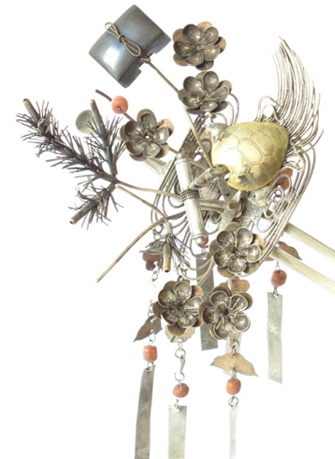
Miriam’s kanzashi is unique. A man with a fishing pole sits on a curved leaf structure, surrounded by dangling chains.
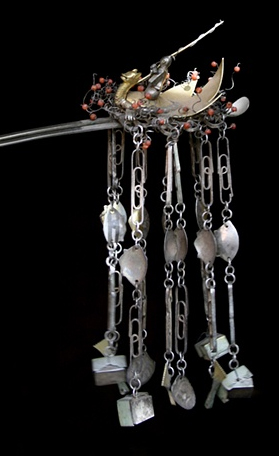
Finally, the Creative Museum has one I absolutely love: a gold fish, whose face looks almost human.
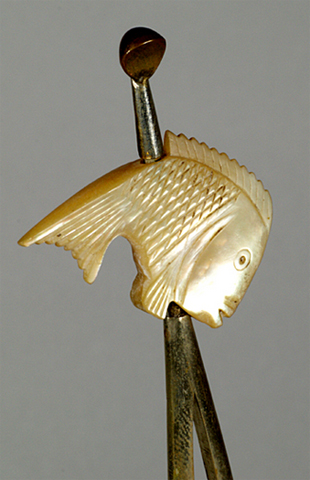
African intellectual history came alive when sculptors placed figures on top of hair combs. These ideas are beautifully shown in Facing Me, Facing You, a video narrated by the Creative Museum.
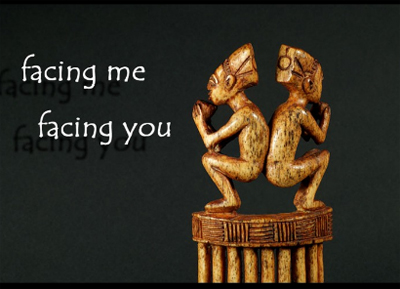
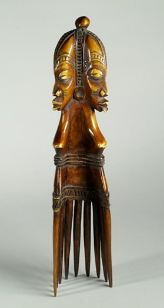
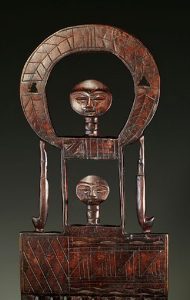
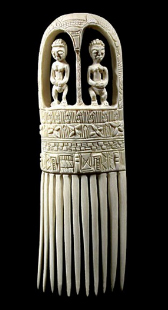
By Miriam Slater:
The Japanese over the centuries have distinguished themselves by their cultivation of humor, fine design and poetry within their art. In fact, these qualities are what originally attracted me to kanzashi. As an artist I found myself entranced by the variety of expression within these beautifully crafted pieces.
Metaphors and symbols are commonly seen in Japanese hair ornaments. For example, in the top image, a silver hair ornament depicts a clamshell, a symbol that can also suggest a woman in the Floating World. When opened up, to the viewer’s surprise, in the shell is a small gold crab, pinchers ready!
The second ornament (of a similar theme) features a closed clamshell and a knife used to pry open clams. The clam’s moveable parts will open to reveal the prize within, a pearl. Symbolic objects are frequently seen on kanzashi which enhance the expression and meaning of each piece. The tortoise comb with a fishing rod can be seen as a metaphor for flirting and courtship with its implied hooking and the reeling in of one’s “catch”.
The crow, a common bird that is noisy and known for its bad manners, graces a red lacquer hair comb as an elegant adornment for a woman of position and beauty. The juxtaposition of what is considered ugly played with utmost beauty reflects the poetic side of the Japanese culture. So, to thoroughly enjoy and understand kanzashi, it really helps to see them not only as finely crafted functional objects, but also as works of art imbued with more subtle meanings.
I stumbled upon hair ornaments by chance, and to this day, I am still moved by this surprising story…
Following studies in Artistic Cabinet-Making and work in a small shop, very soon I felt the need to make woodworking my own, to develop a more personal approach to my trade. With this in mind, I started looking for the perfect medium, the element that would become the focus of my practice.
Through my research, I came across a wonderful book: Le Peigne dans le Monde by Robert Bollé (“Combs of the World”). Mr Bollé comes from a family of comb makers from Oyonnax, former “comb capital of the world.”
Following the two Great Wars, comb popularity declined. Thus, in 1946, Robert’s father Georges Bollé made the first nylon pair of glasses in the world. In 1978, Robert Bollé took over his father’s business. Even though they were now making only glasses, Bollé went around the world and methodically collected anything that was called a comb. He gathered an exceptional collection, most of which is kept today at the Musée du Peigne et de la Plasturgie d’Oyonnax. That is how Robert Bollé came to write this book, and this is how I discovered hair ornaments. This discovery was more than crucial in my young career.
From that moment on, I directed my experimentations primarily on hair ornaments, which offered me a richness in conceptual, aesthetical and technical possibilities. About a year later, during a professional trip to France, I had the great pleasure to visit the Comb Museum in Oyonnax. This was an exceptional event for me.
Following this visit, the Museum curators acquired three of my hair ornaments.
That is how, only a few years after launching myself in comb-making, I had the great honour to enter the collection that had inspired it all…
Of course, I alone cannot claim to revamp sophisticated hair ornaments. Rather, I wish to keep a tradition alive, and to bring a personal interpretation to this mythical accessory. I chose exception and rarity for the love of the material and know-how…
My first hair ornaments experimentations…